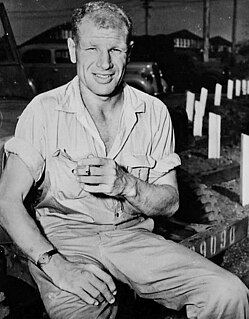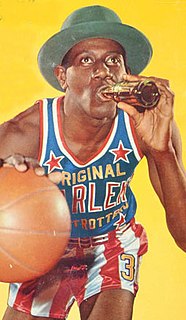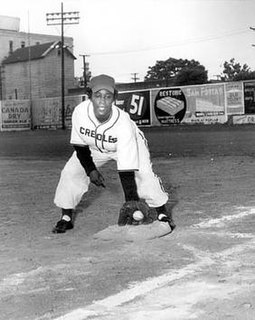Related Research Articles
The Negro leagues were United States professional baseball leagues comprising teams of African Americans and, to a lesser extent, Latin Americans. The term may be used broadly to include professional black teams outside the leagues and it may be used narrowly for the seven relatively successful leagues beginning in 1920 that are sometimes termed "Negro Major Leagues".

Abraham Michael Saperstein was the founder, owner and earliest coach of the Harlem Globetrotters. Saperstein was a leading figure in black basketball and baseball from the 1920s through the 1950s, primarily before those sports were racially integrated.
The Negro American League was one of the several Negro leagues created during the time organized American baseball was segregated. The league was established in 1937, and disbanded after its 1962 season.
The Negro World Series was a post-season baseball tournament that was held from 1924 to 1927 and from 1942 to 1948 between the champions of the Negro leagues, matching the mid-western winners against their east-coast counterparts. The series was also known as the Colored World Series, especially during the 1920s, and as the Negro League World Series, in more recent books, though contemporary black newspapers usually called it simply, the "World Series", without any modification.
The Kansas City Monarchs were the longest-running franchise in the history of baseball's Negro leagues. Operating in Kansas City, Missouri and owned by J. L. Wilkinson, they were charter members of the Negro National League from 1920 to 1930. J. L. Wilkinson was the first Caucasian owner at the time of the establishment of the team. In 1930, the Monarchs became the first professional baseball team to use a portable lighting system which was transported from game to game in trucks to play games at night, five years before any major league team did. The Monarchs won ten league championships before integration, and triumphed in the first Negro League World Series in 1924. The Monarchs had only one season in which they did not have a winning record. The team produced more major league players than any other Negro league franchise. It was disbanded in 1965.
The Newark Eagles were a professional Negro league baseball team which played in the Negro National League from 1936 to 1948. They were owned by Abe and Effa Manley.

William Louis Veeck Jr., also known as "Sport Shirt Bill", was an American Major League Baseball franchise owner and promoter. Veeck was at various times the owner of the Cleveland Indians, St. Louis Browns and Chicago White Sox. As owner and team president of the Indians in 1947, Veeck signed Larry Doby, thus beginning the integration of the American League, and the following year won a World Series title as Cleveland's owner/president.
The Birmingham Black Barons played professional baseball in Birmingham, Alabama in the Negro leagues from 1920 to 1960. They alternated home stands with the Birmingham Barons in Birmingham's Rickwood Field, usually drawing larger crowds and equal press.

Reece "Goose" Tatum was an American Negro league baseball and basketball player. In 1942, he was signed to the Harlem Globetrotters and had an 11-year career with the team. He later formed his own team known as the Harlem Magicians with former Globetrotters player Marques Haynes. He is a member of the Naismith Memorial Basketball Hall of Fame and the Arkansas Sports Hall of Fame. Tatum's number 50 is retired by the Globetrotters.

The East–West All-Star Game was an annual all-star game for Negro league baseball players. The game was the brainchild of Gus Greenlee, owner of the Pittsburgh Crawfords. In 1933 he decided to match the Major League Baseball All-Star Game with Negro league players. Newspaper balloting was set up to allow the fans to choose the starting lineups for that first game, a tradition that continued through the series' end in 1962. Unlike the white All-Star game which is played near the middle of the season, the Negro All-Star game was held toward the end of the season.

Toni Stone, born as Marcenia Lyle Stone in West Virginia, was the first of three women to play professional baseball full-time for the Indianapolis Clowns, in the previously all-male Negro leagues. This also made her the first woman to play as a regular on an American big-league professional baseball team. A baseball player from her early childhood, she went on to play for the San Francisco Sea Lions, The New Orleans Creoles, the Indianapolis Clowns, and the Kansas City Monarchs before retiring from baseball in 1954.
The Indianapolis Clowns were a professional baseball team in the Negro American League. Tracing their origins back to the 1930s, the Clowns were the last of the Negro league teams to disband, continuing to play exhibition games into the 1980s. They began play as the independent Ethiopian Clowns, joined the Negro American League as the Cincinnati Clowns and, after a couple of years, relocated to Indianapolis. Hank Aaron was a Clown for a short period, and the Clowns were also one of the first professional baseball teams to hire a female player.
The West Coast Negro Baseball Association (WCNBA) was one of the several Negro baseball leagues created during the time organized baseball was segregated. The WCNBA was organized as a minor league in 1946 by Abe Saperstein and Jesse Owens as a means to provide the west coast with a platform for African-American players. The league lasted about three months.
The Cuban House of David were a traveling Negro league baseball team that played from about 1928 to 1936 featuring players primarily from Cuba.

William Henry Powell was an American Negro league pitcher for the Pittsburgh Crawfords and Homestead Grays between 1946 and 1948.

Napoleon Gulley was an American Negro league pitcher in the 1940s.

Winfield Scott Welch, nicknamed "Gus" and "Moe", was an American Negro league outfielder and manager. Welch spent most of his playing career with minor Negro teams. He is best known as a successful manager, lauded by some as "the Connie Mack of Negro baseball"

Alvin "Bubber" Gipson, Sr. was an American Negro league pitcher in the 1940s. A native of Shreveport, Louisiana, Gipson spent most of his career in Birmingham as a mainstay of the Black Barons' pitching staff.
References
- 1 2 King, Norm. "Abe Saperstein". sabr.org. Society for American Baseball Research . Retrieved 16 July 2020.
- ↑ "Negro Major League (1942)" (PDF). cnlbr.org. Center for Negro League Baseball Research. Retrieved 16 July 2020.